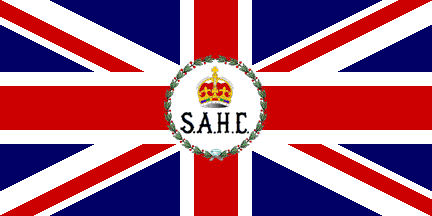 image by
Martin Grieve, 07 Mar 2008
image by
Martin Grieve, 07 Mar 2008
FOTW beschäftigt sich mit der Wissenschaft der Vexillologie (Flaggenkunde).
Alle auf dieser Website dargebotenen Abbildungen dienen ausschließlich der Informationsvermittlung im Sinne der Flaggenkunde.
Wir distanziert uns ausdrücklich von allen hierauf dargestellten Symbolen verfassungsfeindlicher Organisationen.
Last modified: 2015-05-24 by bruce berry
Keywords: swaziland | protectorate |
Links: FOTW homepage |
search |
disclaimer and copyright |
write us |
mirrors
Prior to independence on 06 October 1968 Swaziland was a British Protectorate.
The Protectorate was administered through the Office of the
High Commissioner
in South Africa which was created by Letters Patent in 1878. The High Commissioner
was charged with the conduct of British relations with the
South African
Republic (Transvaal) and the Orange Free State, as well as with "those
native states and tribes outside the colonies of the
Cape and Natal, including
Swaziland" (which was administered by the Government of the South African
Republic under the Convention of 1894). The High Commissioner was also
Governor of Basutoland (now Lesotho) and supervised the affairs of the
Bechuanaland Protectorate (now Botswana) and Swaziland.
The High Commissioner in and for South Africa was
divided into the posts of Governor-General (of South Africa) and the High
Commissioner of Basutoland, Bechuanaland and Swaziland in 1931 and both posts had distinctive flags of their own.
Bruce Berry, 19 Feb 1998
 image by
Martin Grieve, 07 Mar 2008
image by
Martin Grieve, 07 Mar 2008
This image is based on an illustration of a flag which
is on display in the National Museum in Mbabane and which was photographed by
FIAV President Michel Lupant during a recent visit to the country. Next to
the illustration is the following explanation:
"This flag was flown in 1894 when Swaziland had a Triumvirate Government made up
of Swazi, Boer and British People. Theophilus Shepstone represented Swaziland.
The flag is a rough illustration based on general descriptions, as there are no
photographs or drawings of the original".
The flag has eleven alternating equal dark and light blue stripes with a Swazi
shield, also placed vertically, in the centre. Other than the above explanation,
there is no indication of the symbolism of this flag
or for how long it was used. The indication from the above explanation, however,
would suggest that the flag was flown prior to the proclamation of the
Zuid-Afrikaansche Republiek protectorate over the
territory.
Bruce Berry, 07 Mar 2008
 image
by Antonio Martins, 02 Mar 1999
image
by Antonio Martins, 02 Mar 1999
The Swazis were able to retain their independence despite pressures from British and Boer settlers during the late 19th century. However, through negotiation in 1894 the Swazis accepted a Zuid-Afrikaansche Republiek (ZAR) protectorate and accordingly flew the Transvaal vierkleur until 1902.
 image by
Clay Moss, 19 Dec 2006
image by
Clay Moss, 19 Dec 2006
Following the defeat of the ZAR
(Transvaal) by the British in the
Anglo-Boer War, Swaziland became a British protectorate in 1903. The
protectorate did not have a distinctive flag of its own and the Union Jack was
flown until independence in October 1968.
Bruce Berry, 19 Feb 1998
 image by
Martin Grieve, 11 May 2003
image by
Martin Grieve, 11 May 2003
The High Commissioner flew a British Union Flag charged in the centre, on a white roundel, with the letters S.A.H.C. in black above which was a Tudor Crown, all within a green garland of laurel. This flag, which was taken into use in 1907, is similar in design to that of the Western Pacific High Commissioner.
This flag was used until 1931 after which the posts of
Governor-General (of South Africa) and
High Commissioner were separated.
Bruce Berry, 19 Feb 1998
 image by
Martin Grieve, 15 Nov 2005
image by
Martin Grieve, 15 Nov 2005
In 1931, the posts of High Commissioner of Basutoland, Bechuanaland and Swaziland and Governor-General of South Africa were created, the former being responsible for the administration of the British Protectorates in southern Africa.
The High Commissioner, based in
The High Commissioner flew a British Union Flag charged in the centre, on a
white roundel, with the letters H.C. in black, ensigned of the Imperial State
Crown proper, within a garland of green laurel.
Swaziland was the last of the High Commission territories to gain independence,
after which the flag of the High Commissioner fell into abeyance.
Bruce Berry, 13 Feb 1998
Hosted by: Fanshop-Online.de und Handy-Shop.de
Tip: Handy mit Vertrag